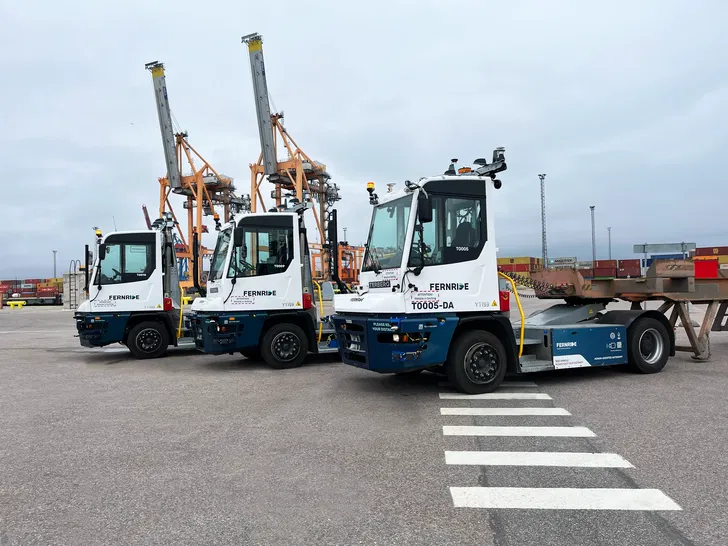Remarkable Leap in Autonomous Technology
Fernride has etched its name in history by becoming the first company in Europe to operate driverless terminal tractors commercially. This groundbreaking achievement came after securing the required certifications from TÜV SÜD and the Estonian Transport Administration. This could very well represent a drastic transformation in logistics, affecting everything from operations to cost efficiency.
Puncte cheie
- Driverless Operation: Fernride operates driverless terminal tractors at HHLA TK Estonia terminal in Muuga, near Tallinn, Estonia.
- Remote Monitoring: A remote operator can monitor multiple (currently four) autonomous trucks, intervening only when necessary.
- Software Monetization: The company employs a software-as-a-service model, intending to enhance operator efficiency.
- Gradual Rollout: Fernride focuses on integrating autonomous technology smoothly, training customer personnel along the way.
Noua eră a logisticii
The deployment of autonomous vehicles marks a major shift not just for Fernride, but for the entire logistics landscape in Europe. Positioned within the Estonian seaport of Muuga, this initiative eliminates the need for safety drivers. Instead, the company has implemented a 1:4 remote operator model, allowing one person to oversee four vehicles simultaneously.
În conformitate cu Hendrik Kramer, CEO and co-founder, the TÜV SÜD certification reflects that Fernride meets the stringent EU standards for safety, cybersecurity, and system reliability, thereby paving the way for a broader industrial application of autonomous technologies across Europe.
Significance of TÜV SÜD Certification
This certification confirms compliance with the EU Machinery Directive, which assures customers and stakeholders that the technology employed is reliable and safe. This level of assurance translates into increased consumer trust, essential for a successful rollout of any new technology in logistics.
The Road to Unmanned Operations
This venture into driverless transportation is not just about technological advancement; it’s a journey that’s been six years in the making. Kramer elaborated that this initiative is part of a broader ambition to establish a generational tech company focused on autonomous driving solutions in Europe.
A Contrast to U.S. Operations
Interestingly, while U.S. autonomous trucking still involves safety drivers, Fernride’s unique approach allows for operations without personnel in the cabin. The autonomy could lead to significant reductions in operating costs, which is music to the ears of logistics companies looking to optimize their expenses. Kramer highlighted that proving this works in Europe makes this certification pivotal for building trust among customers and stakeholders.
Collaborative Future with HHLA TK Estonia
Riia Sillave, CEO of HHLA TK Estonia, emphasized the collaborative move into driverless terminal transport as a future-oriented endeavor for terminal operations. The potential for efficiency gains cannot be overstated, as this innovation promises to streamline logistics activities.
Remote Control and Learning AI
The design of the autonomous systems incorporates continuous over-the-air updates, allowing for AI learning from real-world operational scenarios. These upgrades ensure that the technology remains at the cutting edge, adapting to unforeseen circumstances, like a bird unexpectedly blocking a truck’s path. It’s a safety net that enhances the entire logistics operation.
Powertrain Flexibility in Operations
Fernride’s technology is powertrain-agnostic. It supports retrofitting for both diesel and electric vehicles. This flexibility enables companies to adapt their existing fleets without excessive costs, allowing for a smooth transition into greener logistics. The current Estonian models are diesel, but plans to incorporate electric options are already in motion.
Flexible Business Model for Sustainability
Fernride further monetizes its technology through an annual software subscription. Plans are in place to improve the operator-to-vehicle ratio from 1:4 to 1:6 next year and eventually to 1:8 by 2027. This approach illustrates a sustainable business model that not only benefits the company but also provides customers with the flexibility they need in an increasingly competitive market.
Integration with Customer Operations
As part of the effort to ensure smooth operations, Fernride has trained its team to share operational expertise directly at customer sites. The goal is clear—equip customers to adapt to new realities that autonomous vehicles unveil. Training sessions for customer operators and service teams will allow for a seamless transition.
Privind înainte
While some engineers may prefer a rapid deployment of six fully operational autonomous tractors, Kramer reassures that gradual integration is far more beneficial for clients. Incrementally proving operational capability ensures that disruptions to existing workflows are minimized, a smart approach in the world of logistics.
Concluzie
The journey into autonomous logistics is just beginning but holds tremendous potential for the future. Companies can significantly cut costs while improving efficiency, transforming the entire logistics sector. Although reviews and early feedback can heighten interest, nothing compares to the benefits of firsthand experience. For your transport needs, GetTransport.com offers reliable, global cargo solutions tailored to all types of logistics—whether it be home or office moves, deliveries, or transporting bulky goods. Explore the convenience, affordability, and extensive options that GetTransport.com provides, and Rezervă-ți cursa to streamline your logistics today!

 Călătoria de pionierat a Fernride în operațiunile cu tractoare terminale fără șofer">
Călătoria de pionierat a Fernride în operațiunile cu tractoare terminale fără șofer">